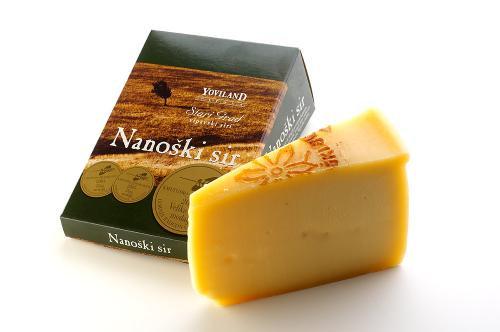
Many visitors to Slovenia notice a prominent mountain as they drive from the country’s interior to the Adriatic coast: Nanos, a popular destination for hikers and the site and the site of a major television transmitter. But the mountain has another claim to fame – it’s the home to Nanos cheese.
Nanos and the surrounding highlands have a long tradition of cheese making. The earliest records of cheese production date back to the 16the century, when the cheese was made from sheep’s milk. For the local herdsmen, making cheese was borne out of necessity: Because of the great distances and the sparse population on the plateau, they were not able to sell fresh milk quickly enough and had to turn it into cheese, which was less perishable.
Over the years, a distinctive type of cheese developed on Nanos. Yellow inside and encased in a reddish crust, the cheese is a product of the unique environmental conditions of the area. The climate and the unique flora of the windswept plateau give the cheese its distinctive taste. The strong bora (“burja”) winds, which are also a key ingredient of the Karst prosciutto (“pršut”), play a key role in ripening the cheese, and they make it unlike any other variety produced in Slovenia.
Despite its venerable history, Nanos cheese almost vanished after World War II. Modernization and a decline in the number of sheep forced the largest local diary to stop producing cheese altogether in the 1950s. This could have spelled the end of one of the area’s most ancient traditions, but a growing demand for high-quality, locally made products ultimately saved Nanos cheese. Production restarted in 1986, with demand increasing every year. Today, 80 metric tons of the cheese are made every year, all for domestic consumption.
Because sheep are now rare on Nanos, the cheese is made from cow’s milk, but its production is subject to strict rules to ensure its authenticity. The milk can only come from a specific breed of cow, and all animals must graze on the pastures of Nanos, the Vipava Valley, the Karst area, and the surrounding highlands. Even minor details – such as the temperature of the milk during processing – are carefully prescribed to ensure that the cheese reflects the traditions of this unique area.
The strict rules have made the cheese eligible for protection on an international level, and in 2011, Nanos cheese was added to the EU’s list of protected regional specialties. Officials hope that this step will help the centuries-old variety of cheese survive in an increasingly globalized world.


































































